
Apamea is a genus of moths in the family Noctuidae first described by Ferdinand Ochsenheimer in 1816.

Rhizedra lutosa, the large wainscot or Isle of Wight wainscot, is a species of moth of the family Noctuidae. It is native to the Palearctic realm. It has been introduced into eastern North America and is spreading.

Apamea cinefacta is a moth of the family Noctuidae first described by Augustus Radcliffe Grote in 1881. It is found in western North America, including in Washington and Alberta.

Apamea commoda, the southern Quaker, is a moth of the family Noctuidae. The species was first described by Francis Walker in 1857. It is native to North America, where it is distributed from Nova Scotia west across southern Canada to southern British Columbia, north to Alaska and Yukon Territory, and south at least into Manitoba.
Apamea contradicta, the northern banded Quaker, is a moth of the family Noctuidae. The species was first described by Smith in 1895. It is native to northern North America, where it can be found across southern Canada from Newfoundland and Labrador west to Alberta and south to Colorado.
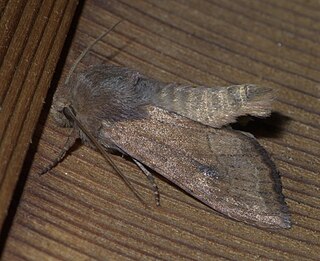
Apamea inficita, the lined Quaker is a moth of the family Noctuidae. The species was first described by Francis Walker in 1857. It is native to North America, where it can be found from Newfoundland west to British Columbia, north to the Yukon and the Northwest Territories, and south to Colorado.
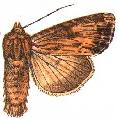
Apamea lignicolora, the wood-coloured Quaker or wood-coloured apamea, is a moth of the family Noctuidae. The species was first described by Achille Guenée in 1852. It is native to North America, where it is distributed across much of Canada and the United States.
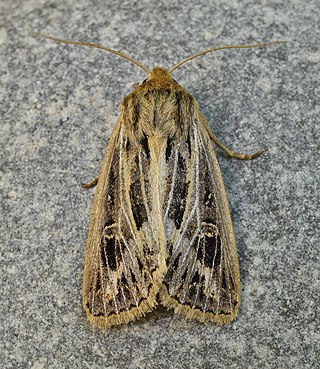
Apamea niveivenosa, the snowy-veined apamea, is a moth of the family Noctuidae. The species was first described by Augustus Radcliffe Grote in 1879. It is native to northern North America, where it can be found across Canada and south to California.

Apamea plutonia, the dusky Quaker or dusky apamea, is a moth of the family Noctuidae. The species was first described by Augustus Radcliffe Grote in 1883. It is native to northern North America, where it occurs across the boreal regions, with some occurrences from as far south as New Mexico and Pennsylvania.

Apamea scoparia is a moth of the family Noctuidae first described by Kauri Mikkola, Tomas Mustelin and J. Donald Lafontaine in 2000. It is one of the most common and widespread North American Apamea, being distributed from Newfoundland and Labrador to Alaska and British Columbia, and south to California and Arizona.

Apamea apamiformis, known by the common names rice worm moth, riceworm, and wild rice worm, is a moth of the family Noctuidae. It is found in North America, including Wisconsin, New York, Minnesota and eastern Canada, with imperiled or critically imperiled populations in Maryland and Indiana, respectively, and a vulnerable population in New Jersey.

Apamea verbascoides, the boreal apamea or mullein apamea, is a moth of the family Noctuidae. The species was first described by Achille Guenée in 1852. It is native to North America, where it is found from Saskatchewan to Newfoundland and Labrador and south to North Carolina.
Apamea inebriata, the drunk apamea, is a moth of the family Noctuidae. It is found along the east coast of North America from Nova Scotia to North Carolina.

Apamea cariosa is a moth of the family Noctuidae. It is found in the northeastern United States, including New York, Maryland, Indiana and Virginia. In Canada it is found in Ontario, Quebec, New Brunswick, Alberta, and Manitoba.
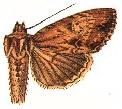
Apamea cristata is a moth of the family Noctuidae. It is found in the northeastern United States, including Michigan, New Hampshire, Maryland, New York, and Pennsylvania. In Canada it is found in Quebec and New Brunswick.

Apamea inordinata is a moth of the family Noctuidae. It is found in the United States, including New York, Massachusetts, Pennsylvania, Colorado, and California. In Canada it is found in Ontario, Quebec, New Brunswick, Nova Scotia, British Columbia, Alberta, Saskatchewan and Manitoba. Its wingspan is about 34 mm. The species is listed as threatened in Connecticut.
The coastal plain apamea is a moth of the family Noctuidae. It is found in scattered populations from Ontario, Quebec, New Brunswick, Nova Scotia and Manitoba in Canada south along the coast to New Jersey and North Carolina. Also inland in New York and western Maryland. It has also been reported from Massachusetts, Maine, Michigan and Ohio.

Apamea rubrirena is a moth of the family Noctuidae.
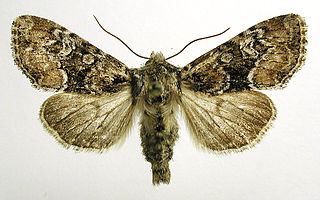
Apamea illyria is a moth of the family Noctuidae. It is found in much of Europe, western Siberia, Turkey, and the Caucasus.

Apamea quinteri is a species of cutworm or dart moth in the family Noctuidae. It is found in North America.







